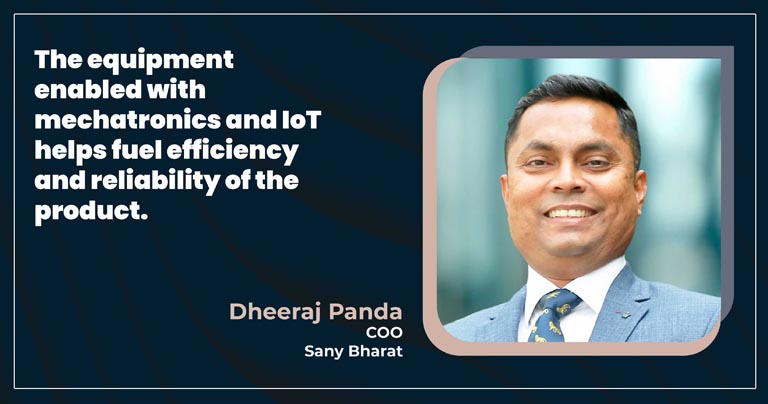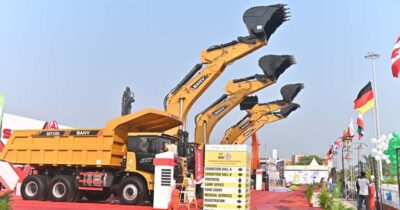Our mechatronics with the IoT increases equipment efficiency
By Edit Team | December 8, 2022 2:00 pm SHARE

In an exclusive interaction at IMME 2022, Sany talks about their latest innovations and shares their views about the trend of digitalisation.
Can you talk about your participation at IMME?
We are a strong competitor for mining equipment today. We have an extensive collection of excavators on display in the current mining machinery exhibition, starting with a 50-ton machine with a 3.1-cubic-meter bucket (SY500) and moving up to a 58-ton machine with a 3.6-cubic-meter bucket (SY580). Among the advancements on display are the 87-ton machines SY870 and SY980, new introductions to the Indian market for buyers, and a 100-ton excavator with a 6.5-cubic-yard capacity. We are also in the mining segment of India through our graders, the SMG200. The state-of-the-art SKT105S Mining Dumpers is the next model in Dump trucks that we are displaying, and, as you know, the SKT 90 S Dump trucks are also very successful, with about 450 units running in Indian mines today.
How far is efficiency a critical factor in equipment performance?
It’s a crucial element since, in the case of mining, it is what makes or breaks a contract. Currently, there are primarily two types of contracts in the Indian mining industry: the MDO, or mine development and operator, type of contract, which typically lasts seven years up to 30 years, and the typical raising contract, which is a four- to seven-year kind of integration. Efficiency, fuel efficiency, productivity, and the mix the client uses are among the most important aspects that may make or break a contract volume in each of these contracts. As a result, the level of efficiency that this combination of an SY 870, a mining excavator, and a 60-ton SY105S mining truck brings to the mining environment sets a new benchmark in terms of fuel consumption and overall efficiency. And we provide the package for complete maintenance contracts when the customer purchases both of these machines and the best Trump trucks.
How do you see the adaptation of non-fossil fuel machines in the Indian market?
Although that is one of the most desired technology trends for the Indian market, there is also a problem with the outdated environment. The ecosystem supporting it must be in place, so we moved away from non-fossil fuels like hydrogen fuel cell technology and battery-operated trucks. There have been some placements and trials, and we will also be conducting these trials in the Indian market to observe the results, but it will be some time before we see the real switchover. Consequently, even though the intent is there—the intent in practically all OEMs and these energy-generating corporations like Coal India or the major mining firms of India—there is still some time before we see the switchover.
Digitalisation is impacting all kinds of businesses around the world. How is it transforming the mining business?
We use mechatronics to create machines with IoT, and these devices begin communicating with one another, as well as the operators, owners, and original equipment manufacturers. Therefore, it is crucial to comprehend the machine parameters to develop efficiency. These parameters may include remote parameters such as fuel consumption, mode of operation, or even the kind of geolocation the machine is in. Other parameters, such as temperature, may occasionally arise if the machine needs to be operated correctly according to the most specific conditions.
When a machine is connected to the Internet of Things, or “IoT,” we may get facts about certain things. This supports the cycle of operator improvement. In the case of truck operators, whether mechatronics-assisted training programmes provide a 10 to 15 percent advantage in fuel consumption or tyre reliability depends on how frequently brakes are applied, whether overspeeding occurs, and what gear the driver should be driving in when the loads are rising or falling. Therefore, those are the critical factors that the trainer can research online.
The majority of businesses, including Sany, are aware of the role that digitalisation plays in the development of equipment, in customising it for certain particular uses and in enhancing operator training and efficiency in terms of the operator manageability of the machine.

What are your views on global supply chain trends, and how are they impacting international market interest?
In the past two years, the availability of components, some of the significant sourcing locations worldwide, and the rise in freight and logistic costs have all caused disruptions in the global supply chain. However, in the past six months, things have stabilised. As a result, freight costs have undoubtedly decreased to nearly pre-pandemic levels, and the supply chain has, of course, been internally built by most of our suppliers, who are among the 400+ vendors we have established in the Indian market. Even though the supply chain market has yet to return to its pre-pandemic level, the supplies or the type of vertical improvisation we wanted to incorporate have occurred over the past few months. Our sourcing is nearly independent of the factors above, such as delays in shipping costs, container availability, or pricing that may impact our margins. Therefore, in terms of supplying or getting components built internally in India, it is for more than just us right now.
Looking at the economic and regulatory policies, what are your views on Indian mining and quarrying businesses?|
We have seen that trend improving in the last two to three years. Based on the global mining scenario, at the very least, because of the general energy need and the government’s stated goals, many MDOs mines, develop, and run. The projects have been granted, and we can see a solid pipeline of interesting mining firms. The government also clearly understands the need for responsible mining. As a result, efficiency and the focus on overall green criteria need to be very effective. We are consequently striving to achieve the same.

Sany Bharat_B2B Purchase
What are the innovations we can expect from you shortly?
The innovation should be in two areas: one will be the electrical operations, and the other will be the machine’s overall efficiency. In terms of innovations in our vision, we are already on the task of improving digitalisation. A significant improvement is coming in that area, and the other improvement will be in the fuel part. The battery-operated trucks will be launched in the market in some time, in terms of our overall fluidity moving from the fossil ones to the non-fossil ones.
Sany has played an essential role in developing the Indian infrastructure, and we are here to contribute to the country’s total equipment growth. We work with practically every type of equipment, including filing rigs, cranes, mining equipment, and road construction, all through an asphalt line. With regards to a leader, we are here to stay, and we are here to expand as India’s infrastructure grows.
Cookie Consent
We use cookies to personalize your experience. By continuing to visit this website you agree to our Terms & Conditions, Privacy Policy and Cookie Policy.




































-20240213125207.png)

























